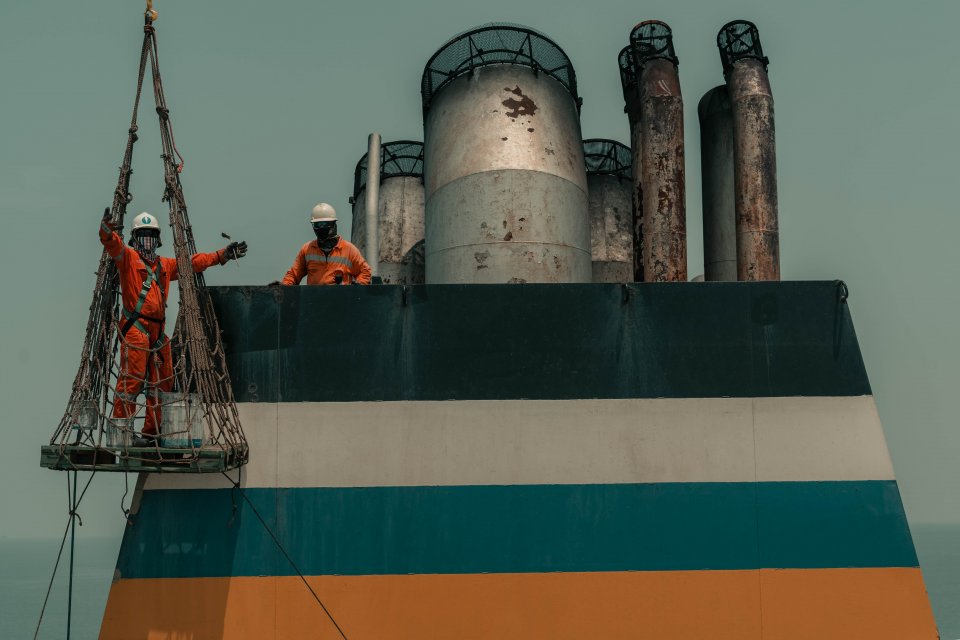
I never imagined 20 years ago that I would be writing a paper about climate change and by extension future ship fuels.
The unusual natural events that have occurred in the last 20 years, such as floods, uncontrollable and unextinguishable forest fires, and year after year of record-breaking air temperatures were indicators that something was not going right.
Every person living on our planet is the cause of global climate change, meaning they create a carbon footprint. A human-caused issue like global climate change, which has an impact on the entire planet, can be brought to public attention through individual actions (in this case, Greta Thonberg's individual actions should be commended), or all the nations of the world can act collectively to form committees and make decisions on reducing greenhouse gases (The right approach would have been to zero out greenhouse gases), thereby limiting the increase in global temperature. Although it was too late, the climate conference organized by the United Nations in Paris in 2015 was the most important step taken in this regard.
WHAT ARE GREENHOUSE GASES?
Due to greenhouse gases, the entire ecosystem is collapsing, and we are on the edge of global destruction. Without understanding the impact of greenhouse gases on global climate change, discussing ship fuel emissions would not be accurate. First of all, I want to explain greenhouse gases very briefly and in a way that everyone can understand.
The sun's rays pass through our atmosphere as short and long wavelength lights and reach our world. Sunlight that hits the land and oceans is converted into long wavelengths and is called infrared light. The amount of energy that was consumed must be equal to that which was consumed. Because solar energy gives 342 watts of energy to each square meter on earth, 342 watts of energy should likewise be emitted. The difference of 2 W/m2 is called the ''''Carbon dioxide climate forcing''. Methane has a climatic forcing of 0.5 W/m2.
Our atmosphere is composed of 78 percent nitrogen, 21 percent oxygen, and 1 percent other gases. Diatomic gases (oxygen and nitrogen) are incapable of trapping rays from our planet. However, when infrared rays hit gases with 3 or more atoms (CO2, CH4, N2O) (carbon dioxide, methane and dinitrogen monoxide), they do not know how to move, half of them escape out of the atmosphere and the other half return to our world.
Carbon dioxide, methane, and dinitrogen monoxide gases that have the potential to trap and return these sunbeams to our earth are called greenhouse gases.
The greenhouse gases in our atmosphere are composed of 81 percent carbon dioxide, 10 percent methane and 7 percent dioxane monoxide. (2018 data)
GLOBAL CARBON DIOXIDE EMISSIONS
The highest CO2 emissions in global carbon emissions are in energy production with 39 percent. This is followed by industry with 30 percent and transportation with 21 percent.
Between 2009 and 2019, the increase in the number of vehicles on the roads from 1 billion to 1.6 billion brought the CO2 emission in road passenger transportation to the first place with 46 percent, while road cargo transportation took the second place with 31 percent and maritime shipment took the third place with 11 percent.
Airline emissions data point to an even larger increase. In the same period, the number of passengers increased annually at that time from 2.5 billion to 4.6 billion. As a result, with 9 percent of the total passenger transportation, the airline transportation follows maritime transportation.
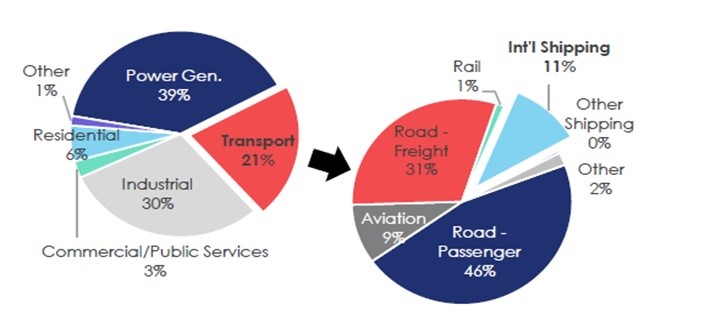
NET ZERO EMISSION RACE
All the countries of the world are working to align themselves with the Paris 2016 climate commitment, limiting the global average temperature rise to 2 degrees, if possible to 1.5 degrees. Here the difference of half a degree is so significant that it doubles the risk of floods and droughts.
The majority of countries’ governments have committed to becoming carbon neutral by 2050. China and India, for example, have promised to be net zero by 2060 and 2070, respectively.
The net-zero commitment has so far been reached by two countries. Surinam with 600,000 inhabitants and Bhutan with 800,000 inhabitants. The greenhouse gas emissions of these two countries are equal to the amount of forested areas that the countries absorb carbon and the amount of carbon captured by carbon capture.
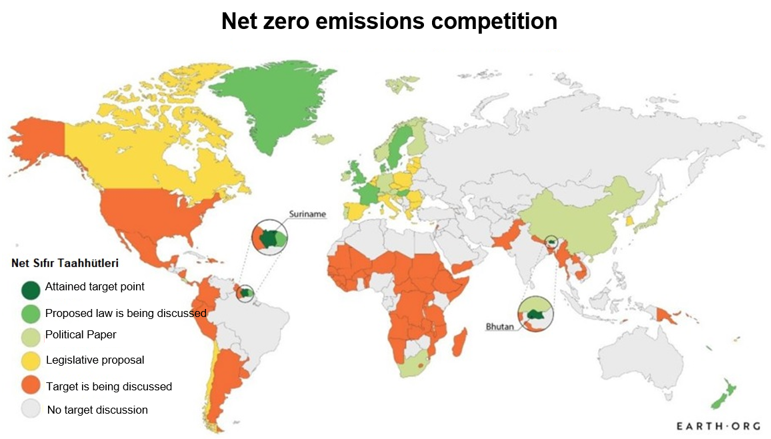
ON THE ROAD TO ENERGY TRANSITION
Over the past five years, the International Energy Agency (IEA) has become increasingly pessimistic about the use of fossil fuels. This is because investments in renewable energy sources have increased.
A 53-member, industry-led, UN-convened Net Zero Banking Alliance has established in 27 countries, representing one-quarter of global banking assets worth 37 trillion dollars.
The Glasgow Financial Association for Net Zero (GFANZ) has more than 250 financial institutions from 32 countries and represents over USD 88 trillion in assets.
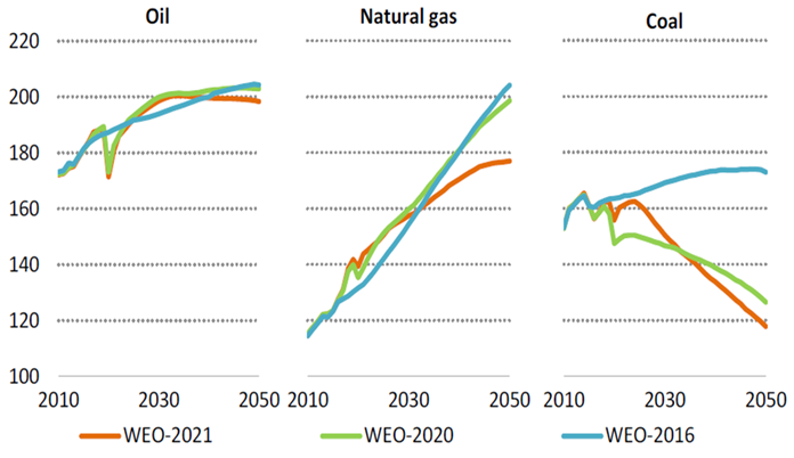
MARINE & CARBON EXPLOSION
The linked table depicts mariners' performance in lowering world CO2 emissions. Why? Despite the 1.020 billion tonnes of CO2 emissions produced in 2008 while transporting 8 billion tonnes by sea, in 2022 the transportation by sea increased to 12 billion tonnes (about 50 percent more), while CO2 emissions were reduced to 851 million tonnes, in other words by 17 percent (170 million tons) compared to 2008. The main reason for this is that ship-speeds are reduced by around 15 percent during this period.
The target for 2050 is 500 million tonnes.
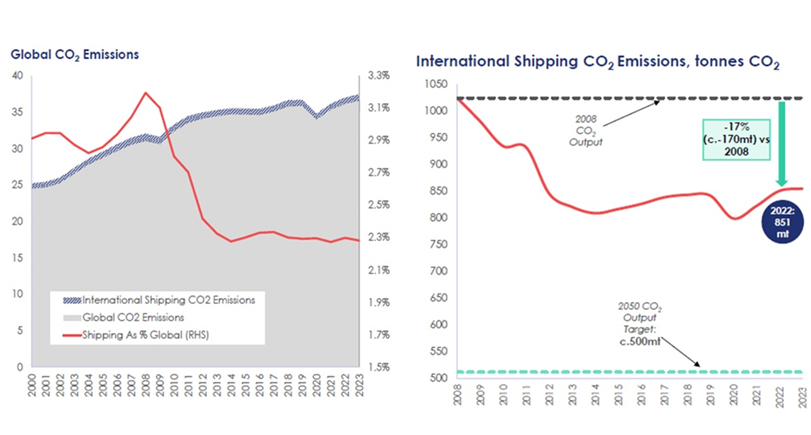
IMO (INTERNATIONAL MARITIME ORGANIZATION) GREENHOUSE GAS FUTURE PLANS
Based on 2008, the World Maritime Organization produced strategies (plans) for 2023, 2030, 2050, and 2100, as well as short, medium, and long-term route and carbon intensity targets.
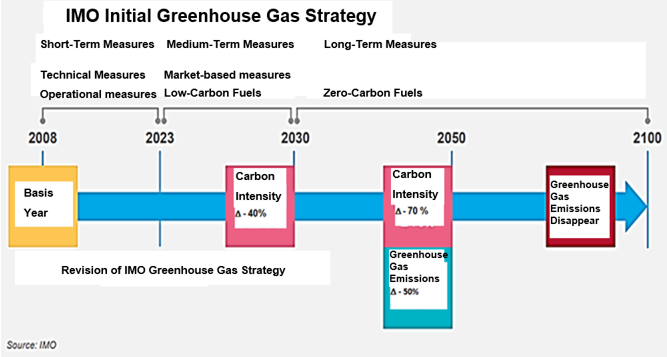
CURRENT SCENARIO
IMO's; In order to reach the target of limiting the CO2 emission to 5 grams in the transportation of 1 ton of cargo by 1 mile by 2030, the most appropriate method is to limit the machine power of the ships and accordingly to reduce their speed.
Of course, in this process, energy efficiency, alternate fuels, and improved propulsion systems will all play vital roles in accomplishing the goal.
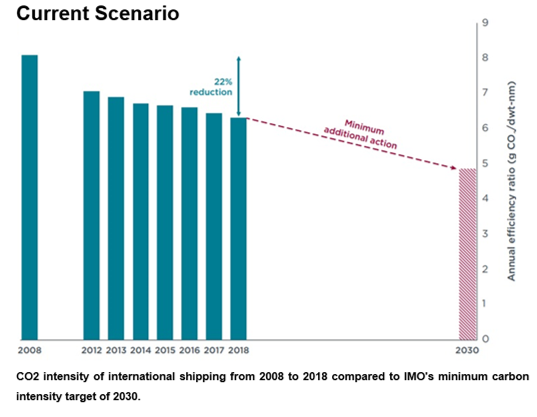
EEXI AND CII
The introduction of EEXI and CII this year will require an assessment of the design and operational carbon intensity of ships. Compliance requirements are binding, with mitigation factors increasing over the years.
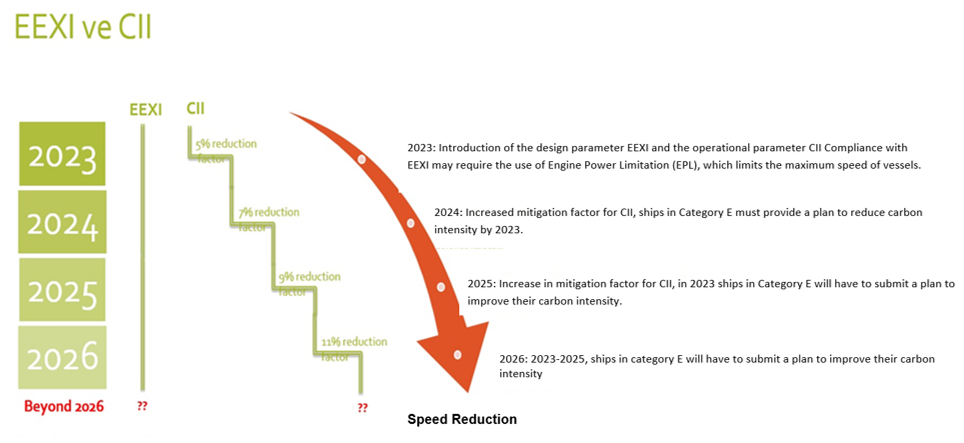
FORMATION OF GREEN CORRIDORS
As we begin to transition to alternative fuels, they are expected to be challenging in terms of fuel availability, acceptability and so on. As a result, major shareholders have teamed up to establish green corridors along a few chosen trade routes. Alternative fuel will be available in these green corridors, thereby encouraging ship owners to deploy ships powered by alternative fuel.
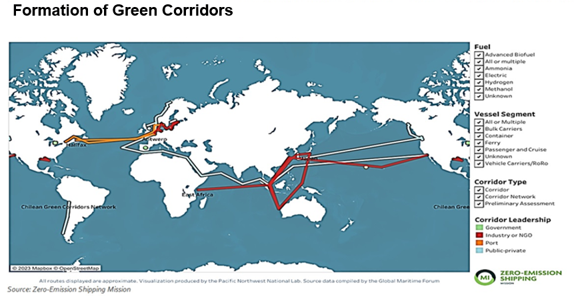
ALTERNATIVE GREEN FUELS
What is green fuel? Fuels produced from the conversion of hydrogen (e-hydrogen) obtained from renewable sources (multiplicity of solar or wind) with other gases are called green fuels. They are often referred to as e-fuels, taking the letter "e" from "green" or eco-friendly.
Here, green fuels, which are on the agenda as the ship fuels of the future; e-hydrogen, e-methanol and e-ammonia will be discussed.
On our planet, where 1 billion people are on the verge of starvation, biofuels produced from vegetable oils on fertile land will not be consciously examined in this article.
The accompanying table shows how green fuels (e-hydrogen, e-methanol, and e-ammonia) are produced. According to this table, green hydrogen is created by electrolysis before renewable sources (solar or wind). Green Ammonia: Green hydrogen produced is with nitrogen, Green Methanol is; It is produced from the conversion of the green hydrogen produced with sustainably captured CO2.
In summary, without the production of green hydrogen from renewable sources, ammonia and methanol, which are shown as the ship fuels of the future, cannot be used as carbon emission-reducing fuels.
I will try to explain the misconceptions in this regard in other tables.
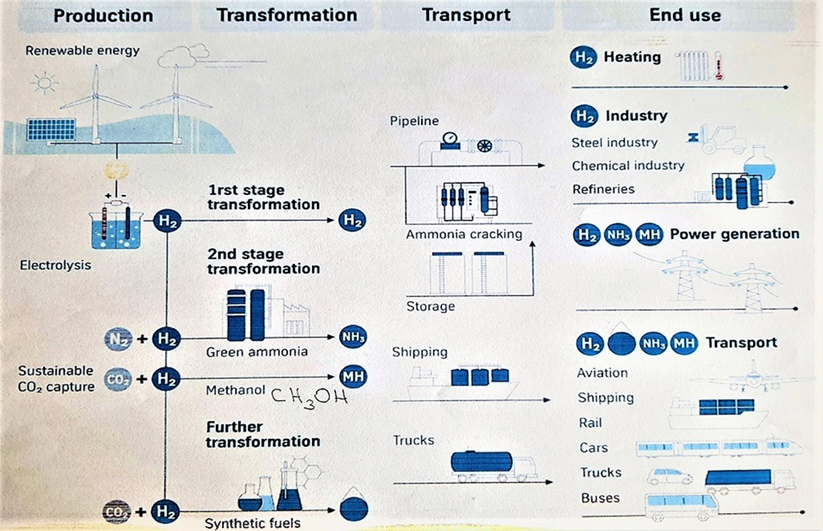
ALTERNATIVE FUEL PERFECTION MAP
There are major challenges in making ammonia a viable alternative fuel. Hydrogen is not included here as it will only be used for short-distance shipping.
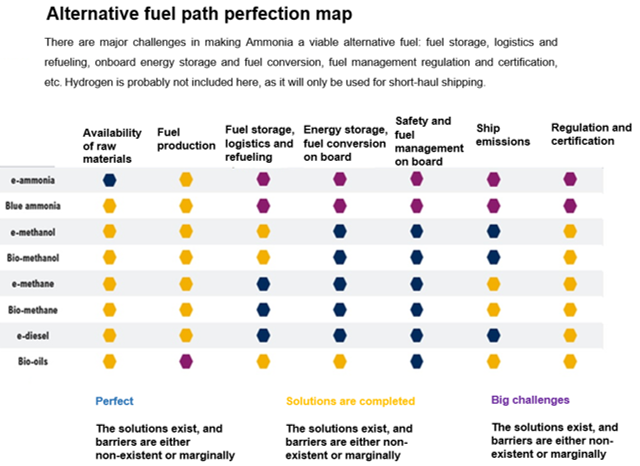
UNDERSTANDING EMISSIONS
This table prepared by Pusan University needs to be examined very well in order to understand the next very important picture.
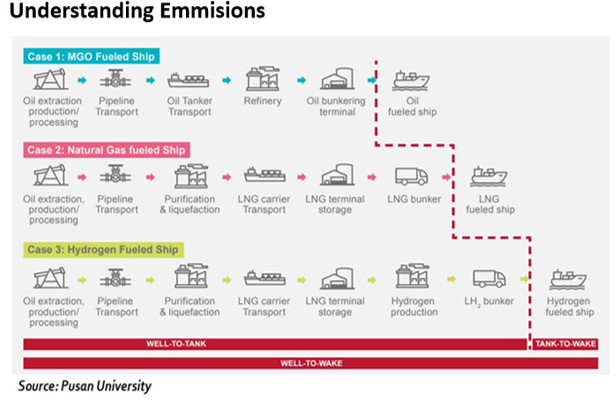
AWARENESS-RAISING EMISSIONS OF DIFFERENT FUELS
WWT; WELL-TO-TANK (Emission from crude oil extraction and production to the ship's tank)
TTW; TANK TO WAKE (Emission induced by fuel burning in the ship's fuel tank)
The table, which was created using the Marine Gas Oil (diesel) carbon emission of 654 grams of CO2 equivalent per kWh, demonstrates that all e-fuels are environmentally beneficial and have low carbon dioxide emissions.
Carbon dioxide emissions begin with the usage of crude petroleum products and natural gas, and the VLSFO emits 663 grams of CO2 equivalent per kWh.
Now that we've arrived at the crux of this lengthy project, the appearance is painful.
Namely; In this study, we have stated in the above paragraphs that e-hydrogen, e-methanol and e-ammonia will be considered as ship fuels of the future.
These three e-fuels are currently derived from natural gas and coal, as they are produced by electrolysis from renewable energy and chemically converted into methanol and ammonia.
In other words, the methanol we see in the fuel market today has nothing to do with e-methanol.
When production is made from natural gas, hydrogen emits 66 percent more carbon than Marine Gas Oil and 40 percent more carbon than Ammonia.
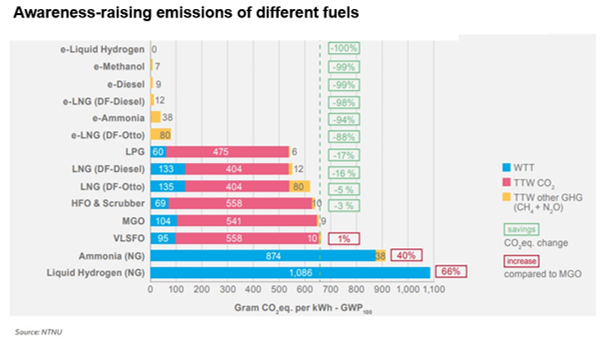
WHICH ALTERNATIVE FUEL WILL BE USED MORE BY 2030/2050
When the 2022 Shipping and Shipbuilding Forecast Forum researches are examined, it will be seen in the attached table how confused shipowners and new ship investors are especially confused about the 2030/2050 forecasts, even in the 6-month period.
If this research were carried out today, very different tables would emerge.
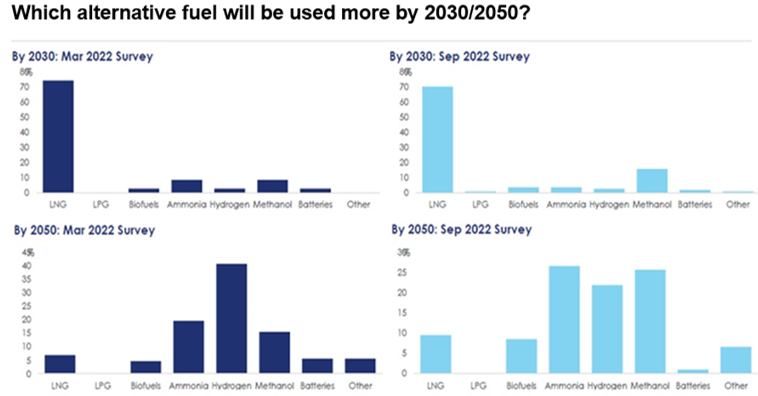
DEVELOPMENTS IN SHIP TECHNOLOGIES
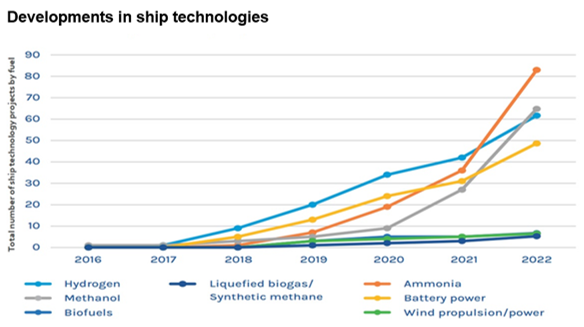
CONCLUSIONS
1) The conclusion is the conclusion of the person who continues and writes this work, and no type of fuel is beautified.
2) In the personal research, three different shipowner groups were observed, the first group; Shipowners who research the subject scientifically and market-oriented and are looking for solutions, the second group; the shipowners who followed the first group, and the third group were; “Steady as Shegoes”, so wait and watch what happens to the shipowners in the mood.
3) Green fuels are primarily fuels obtained from renewable energy (mostly solar and wind energies) through electrolysis. And that's just hydrogen.
4) Mankind, who was able to send the James Webb telescope 1.5 million kilometers into space, has still not solved the problem of energy storage today. When it comes to ships, the only solution is to obtain e-methanol and e-ammonia by chemical conversion of e-hydrogen and use them as fuel on ships.
5) If you imagine a battery, how many batteries are needed to power Tokyo for three days? More than 14 million batteries is the response. That's more storage capacity than the world has produced in ten years. Purchase price; 400 billion dollars.
6) Hydrogen is a type of fuel that can only be used over short distances. It requires ample storage space and cannot be expected to be utilized as a fuel for transoceanic cruise directly. In addition, special tanks are required to maintain a temperature of -253 C to keep hydrogen in a liquid condition. It is a gas that is highly flammable and prone to leaking.
7)The two fuels with the highest aspirations for the fuel of the future methanol and ammonia are currently made from coal and natural gas GWP (global warming potential) is 40 percent-66 percent above marine gasoil.
8)The marine sector's green fuel requirement requires 971 nuclear reactors or 139,000 wind turbines or 2.2 billion solar panels.
9) Green ship fuel, by the most optimistic calculation, will be 4 times the price of current fossil fuels.
10) Shore connection should be connected to berths in all ports by 2030.
11)State and civil-public maritime organizations in our country should start negotiations for the production of e-hydrogen from renewable sources as soon as possible.
12)Universities should start developing ‘carbon capture on board' (author's note; the only solution I can see) as soon as possible, because ships will now have 'carbon officers' alongside deck and machinery officers.
13)The global production of green methanol and ammonia is still in its infancy, but it is known that Europe is doing very serious work on this issue.
14)Today, fuel emissions are measured from tank to wake. The ''well to propeller'' measurement method, in which all production processes are taken into account until the fuel comes to the propeller, is gradually adopted. It will be impossible to use ammonia and methanol generated from natural gas and coal at sea in this circumstance.
15)Since the emission of older ships is higher, charterers will prefer higher rated vessels, which will create a challenge in the usage of older ships.
16)There will be a significant capital investment need after 2025, when ships operating on alternative fuels will start to be ordered. According to some estimates, decarbonizing shipping will require a budget of more than 3 trillion US Dollar. Funding will only be available for climate-compatible projects from some financiers.
17) 1 percent of current global tonnage uses alternative fuels. In new building orders, this rate rises to 22 percent, but half of this rate is made up of LNG, which is a fossil fuel.
18) It will be a very difficult road ahead for shipowners and ship investors. To rescue our world, everyone from alternative fuel producers, ports and terminals, shipowners and operators, regulatory and policy-making agencies and organizations, financiers, freight owners, and customers must collaborate and take action.
19) May God grant all shipowners ease during this trying time.
Levent Akson
Doğançay, June 2023
References:
In the past two years, foreign papers about future ship fuels have been published,
Collaborating with climate analysts
ClarksonsResearch
Son Buzul Erimeden – Prof.Dr. Levent Kurnaz
2035 sonun başlangıcı – Prof.Dr. Ali Demirsoy
İklim Felaketini Nasıl Önleriz (How to Avoid a Climate Disaster) – Bill Gates

Comments ( 0 )